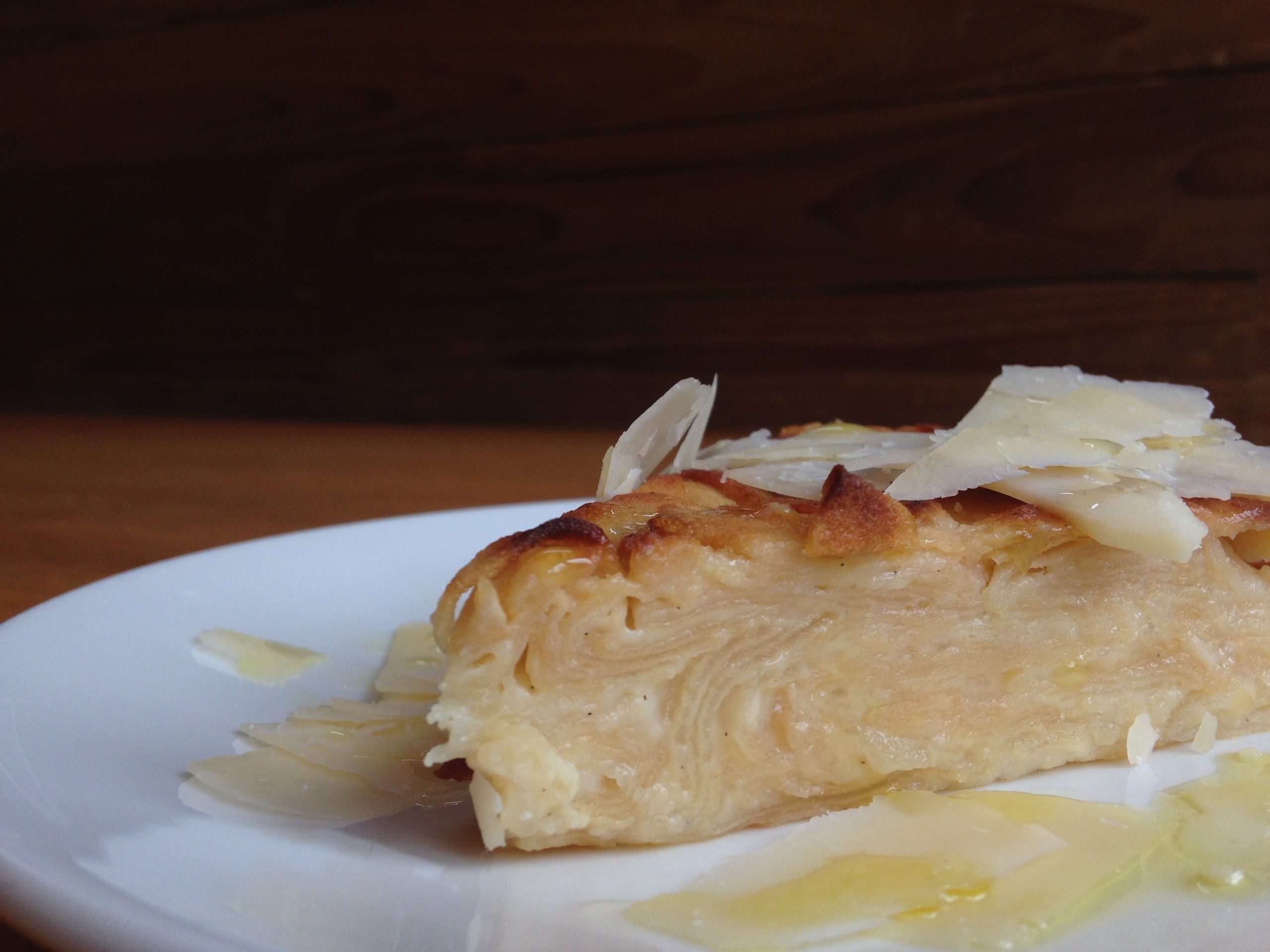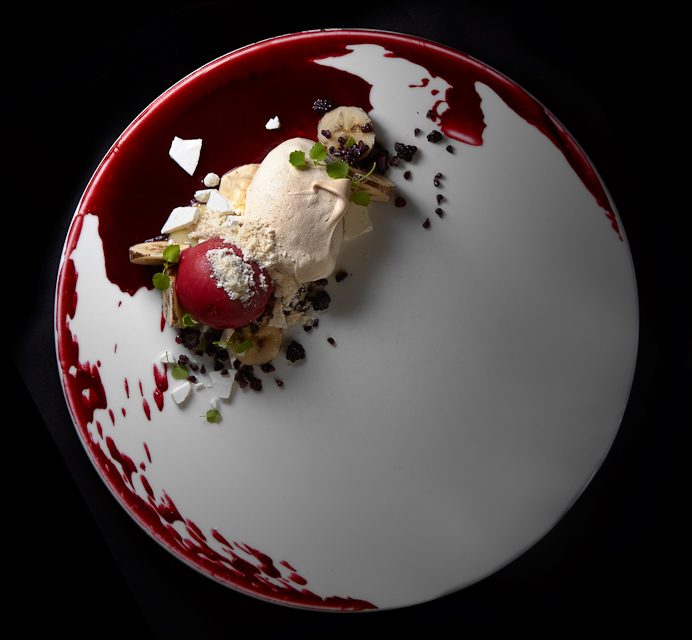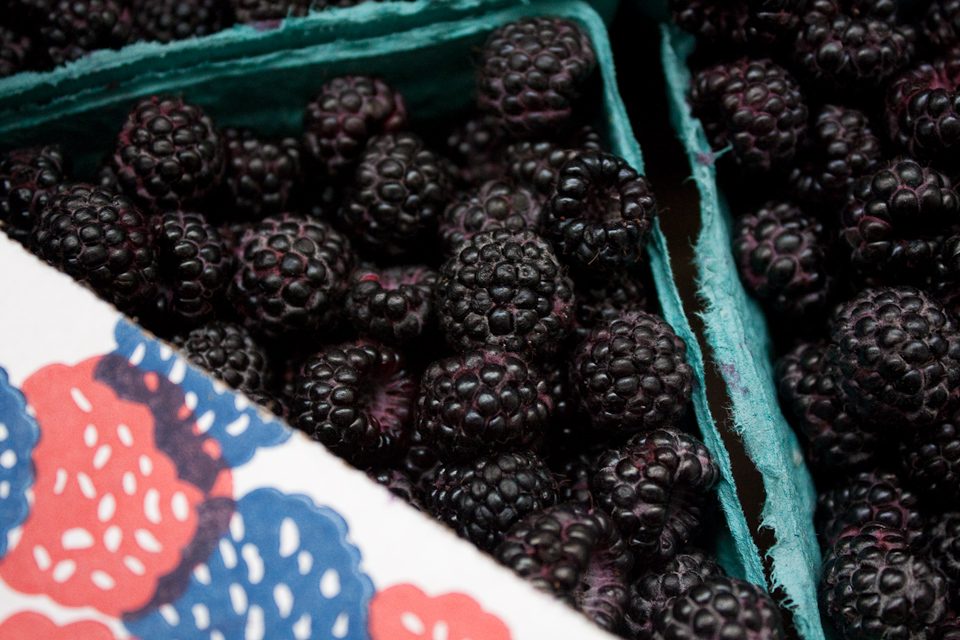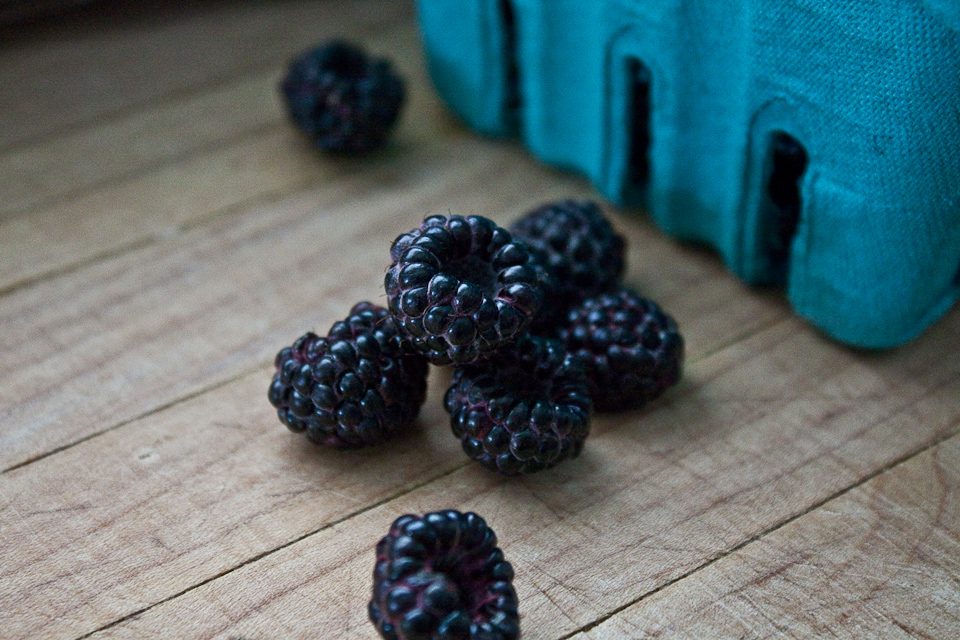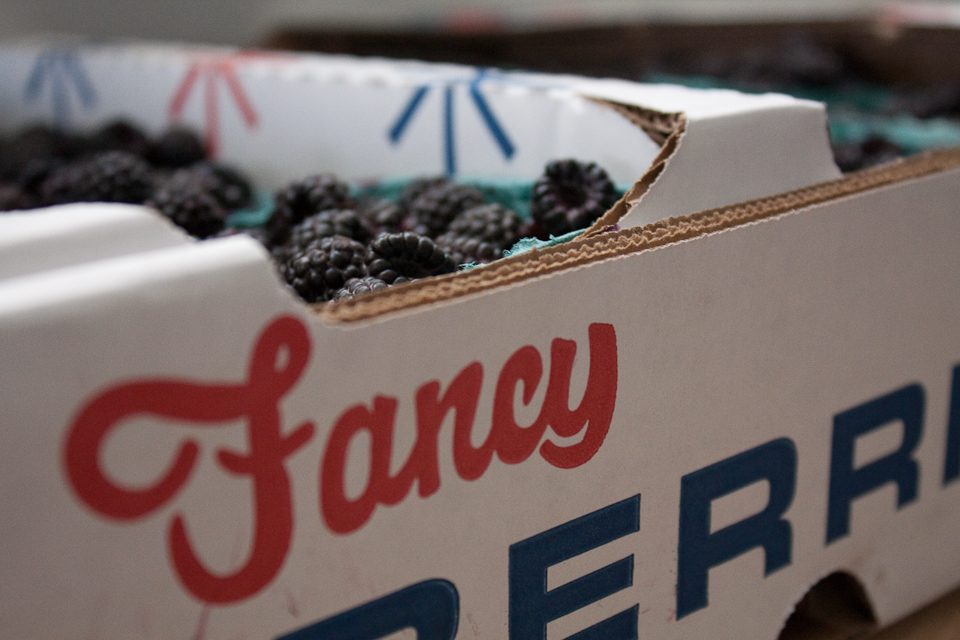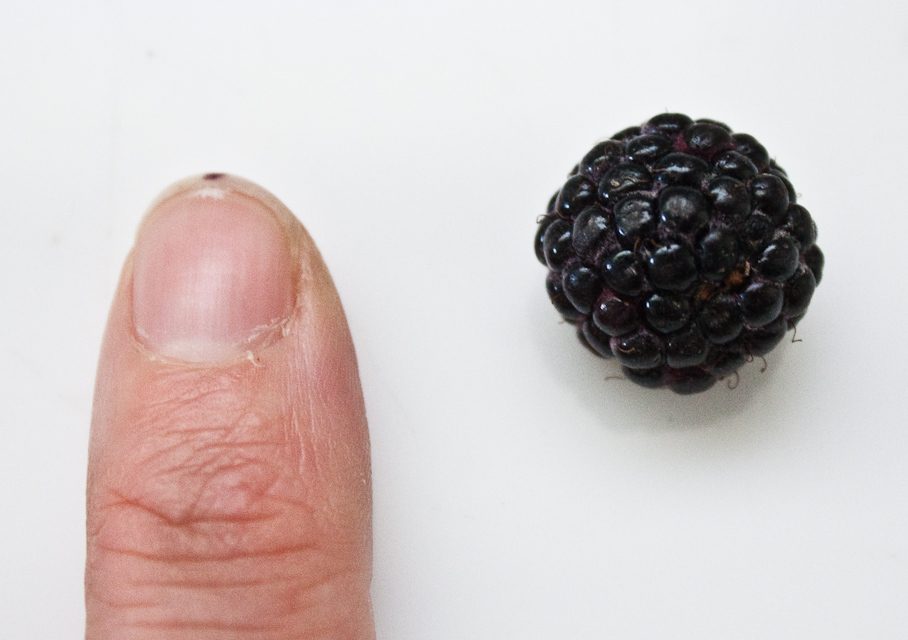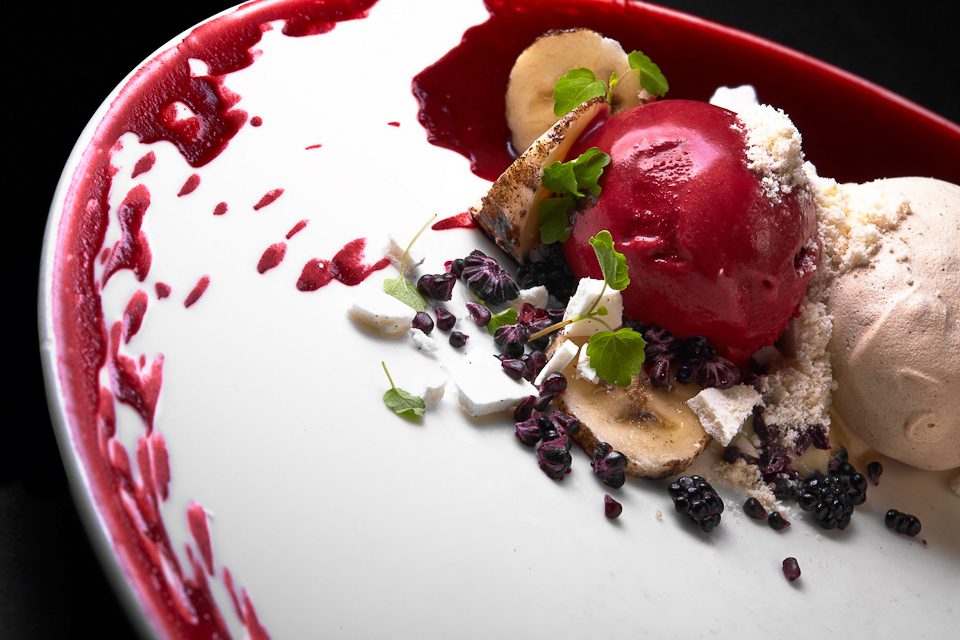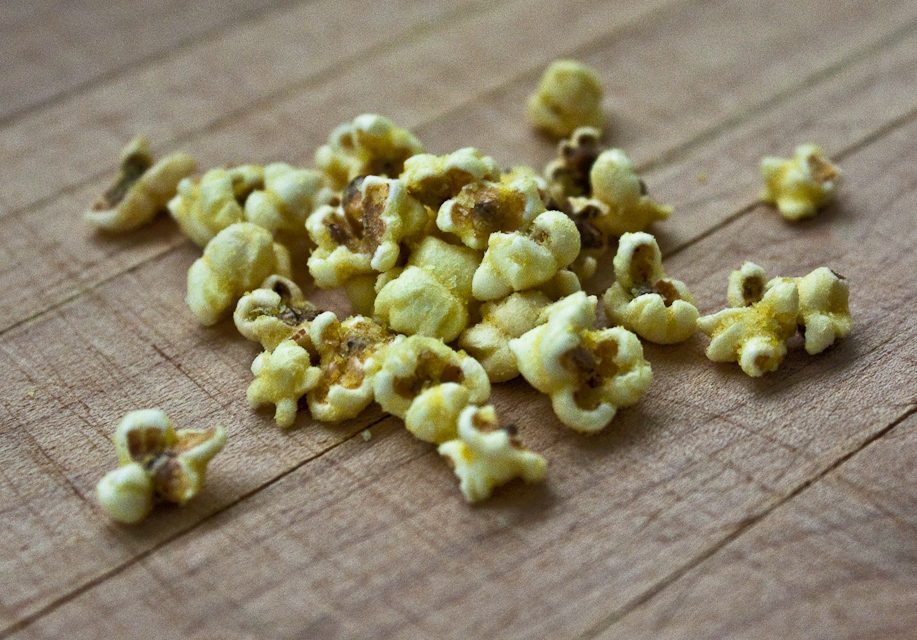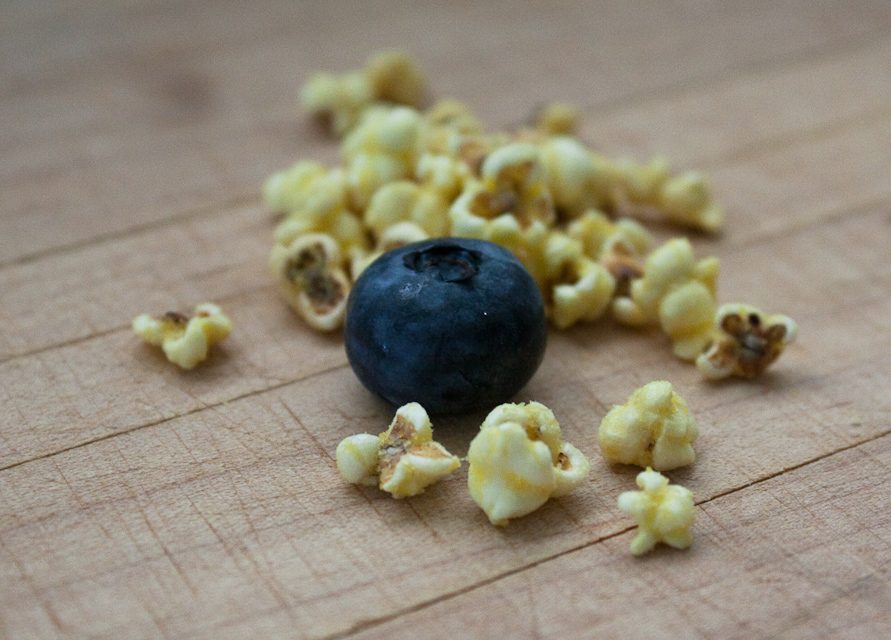Friday, Dec 27th, 2013 by Dana Cree
Adventures In Setting Cream
Crème Brulee. Pot du crème. Panna Cotta. Custard. Pudding. Pastry Cream. Yogurt. Crème Fraiche.
A pastry professional spends a lifetime setting dairy.
Every time we do this we are attempting one thing; to disrupt the fluidity of dairy with enough matter change it from a liquid to a solid state. Sound complicated? It’s not, I’ll bet you have watched this simple act of magic happen yourself.
At it’s best, it can be done so delicately, the solid state reverts into liquid moments after it hits our tongue.
In our employ are proteins, enzymes, starches, bacteria, and alginates, all introduced to the liquid phase of dairy with the sole purpose of holding our delicious milks and creams in place long enough for us to transport them from a service piece into our mouths.
Here in our pastry department our recent foray into setting cream elegantly utilizes the protiens that exist in dairy naturally. A dessert pulled from the ages, Posset is a velvety custard made of cream, sugar, and acid. With a simple addition of an acid, commonly lemon juice, we lower the PH of the cream.
As the PH of the dairy drops and becomes more acidic, those tight little coiled proteins start to loosen up, and unravel. As they unravel they start to crisscross, creating a network of proteins so entangled, the water molecules in the milk are slowed, and at times immobilized. You’ll be familiar with this transformation if you’ve eaten yogurt, spooned sour cream onto a piece of pie, or let a thick keifer mosey down your throat.
Yogurt, creme fraiche, and keifer all obtain their acidity through bacterial fermentation, which requires a mindful chef and controlled environments. Once introduced, the bacteria begin to feast on the sugars in milk called lactose. They eat and eat, leaving behind lactic acid. Temperature and time must be watched to keep these bacteria lively and healthy.
Possets on the other hand require little attention and obtain all the acid they need from a direct and controlled introduction by the chef. Once combined, the acidulated dairy is left to it’s own devices in the refrigerator overnight. What emerges is custard with a texture somewhere between a creme brulee and sour cream.
Posset found it’s way into our kitchen by way of broad scope testing “cream” textures to work into a peaches-and-cream anchored dessert for blackbird. What resulted is a nectarine (turned pear for winter) poached in bourbon, set aside a posset made with a remarkable cream from Kilgus Farmstead. Lightly scented with rose, this posset employs lemon juice and a small dose of lactic acid. Burnt hazelnuts and bourbon buttercrunch sit in foundation while billowy sheets of caramelized phyllo and torn pickled roses cover the dish.
As research suggested this custard was the origin of panna cotta, it was only natural to find it a home at Avec as well. Cast into traditional Mediterranean terra cotta dishes called casuelas, we flavored this acid set cream with lemon, almond, and vanilla. In search of a name we simply titled it Crème Avec. This luscious custard needs nothing more than a sheer dressing of a sauce made from ripe fruit, in our case a plum caramel.
Friday, Dec 13th, 2013 by Dana Cree
Rice and Chocoalte
We’ve been playing with a lot of starchy components in the blackbird pastry kitchen these days. Specifically, potatoes, rice, and beans. It’s been an interesting venture. A savory cook makes a quick study of the pitfalls and successes of these starches, working with them in their natural state early on in their career. I won’t pretend to say we didn’t have a learning curve. But batch after batch of gluey muck after another, we persevered, determined to utilize the familiar-yet-unexpected texture these savory starches bring to our dessert.
I’d like to say it started with a desire to push my team, to expand ourselves creatively and walk down a road less traveled, however the truth of the matter is it started with a rice cake.
This rice cake is exactly what you think of as a rice cake. Similar in appearance to styrafoam, and made with brown rice. The only differentiating factor between this puck of puffed rice and all the other pucks of puffed rice sitting in cellophane sleeves in your local grocery store was a coating of dark chocolate. It was purchased in a small natural foods grocery store in Freiburg, a town in the German black forest. The fact that the rice cake was purchased in a little village in a far away land may sound romantic, but in actuality this purchase holds all the charm of going to whole foods, and buying a rice cake.
My sister has taken up residence in Freiburg, and subsequently started a family. I splurged this year, and spend the entirety of my vacation time with them, getting to know my new nephew Flynn and my 3 year old niece/hurricane named Vivienne. Upon return, I was welcomed back into my kitchen with the inevitable question, “what did you eat?!”
It would seem natural that a chef traveling in Europe would make their way home with a belly filled to the brim with decadence. However, the priority of this trip was simply family. We cooked all of our meals (my sister makes an excellent quiche) between diapering, chasing, napping, and generally attending to the needs of young children.
So, when I was pressed to name the best thing I’d had while traveling, the honest answer was a rice cake coated in chocolate. It was lovely.
I decided then and there, that a dish could come of it, and we began testing rice textures, to pair with a chocolate. A memory of an ice cream sundae over sticky rice at Ping in portland inspired the textural base of the dish. It was one most memorable dishes I’ve ever eaten. The sweet, bland chew of the rice was the perfect counterpoint to all the familiar textures of an ice cream sundae.
With this textural construct in mind, we steamed, boiled, and folded a variety of rices before coming across a chew that suited our desires, and technique that was successful daily in our kitchen.
Simmered with the turkish chili urfa biber in a pot, glutinous rice is immediatley folded with a sweet and sour date condiment until the starches begin to tighten and pull the sticky rice kernals together.
Our second rice texture is a puffed rice chip, similar in appearance to a chicharon. It is made by overcooking jasmine rice in water, spreading the slurry on a silpat, and dehydrating it. Once dry, a quick dip in 400 degree oil brings the crackly rice chip to life.
The dish itself features the flavors of chocolate, rice, dates, urfa biber, and sesame. A whipped date is spread on the plate and bruleed before a nest of sticky rice is added. 3 pieces of chocolate cremeux, stable enough to be warmed through in the oven are placed over the sticky rice. Crushed sesame brittle tumbles off the cremeux and acts as a seat for Medjool date ice cream. To crown our dish, shards of the crackly puffed rice chips.
It just goes to show inspiration comes from the least likely places. Had my trip been filled with classic european pastries, or the work of other pastry chefs, I might have been distracted from the simple brilliance of a rice cake coated in chocolate, and this lovely dessert may never have found it’s way to us.
Friday, Nov 15th, 2013 by Dana Cree
thinking about gluten and wheat
I make a strong effort to keep one, if not two (or three!) gluten free desserts on the menu at blackbird.
Yes, it’s a hot topic these days, as our awareness of celiacs disease and the effects wheat and grains have on the human body grows. We in the kitchens are catching up, as those in our dining rooms are speaking up. While we are sensitive to protecting every guest that comes through our doors, it was not the solely dietary restrictions that led me to question the roll of wheat flour in my desserts.
My desire to “go gluten free” so to speak began with a conversation with my friend Shauna about 5 years ago. We were in her little island kitchen making pie crusts and generally goofing around. As she continued tell me stories, Shauna described baked goods she was creating that were not only on par with their wheat based counterparts, but dishes she thought surpassed the originals, like her streusel topped apple crisp.
I could see the thought coming towards me like a train on the tracks a mile away. As the whistle blew and the train grew neigh, the thought began to come into focus, until finally I was catching my balance as it flew by me rattling my ears and forever changing my thoughts on “gluten free”.
The thought that knocked me on my heels was this. Baking and pastry has never really thought beyond wheat flour because we never had to. This leaves us with an entire discipline in the pastry world bound to wheat. We were only using wheat in many places because there was no reason not to, thus we never really thought beyond it. It was there, it did a job, and we used it.
But with all the work we as a culinary community have accomplished, pushing the possibilities of texture forward and expanding the knowledge base each chef works with, surely at this point we can think beyond gluten.
Can we liberate the dessert from a dependance on wheat?
By no means do I wish to eliminate wheat flour from our world. It does some pretty amazing things. But sometimes, it just does a basic job that can be done by something else.
The very first thing I did was to reconsider exactly what wheat flour did, then think about other ingredients in my pantry that could do the same job. Working with Shauna helped me realize that wheat flour is basically a double action ingredient. It both adds bulk to desserts, and binds them. Thus I began looking through my pantry for two things rather than one. Things that added bulk, and things that could bind. Henceforth known simply as “bulkers” and “binders”
Once in the kitchen, we followed suit and like Shauna took a look at streusel, a component that is often scattered across a plated dessert for a lovely crispy texture. I gave the task of binding to cornstarch, and after that, it opened up the possibility of any flavor flour or meal we desired. Chestnut! Buckwheat! Corn! Kinako! Oat! Cocoa powder! Milk powder (thanks to Christina Tosi)! Burnt wheat!
I know, we were trying to get the wheat out, right? Well, we were trying to think beyond it. When wheat flour is roasted, it looses it’s ability to swell and bind. But it tastes amazing. So when you let it just act as the bulker and find another binder, you’re back in business.
The second place we eliminated wheat flour was from the cookie dough in cookie dough ice cream. If it’s not going to bake, it just needs to be bulky. So there is definitely no need for wheat flour. I took advice from Shauna again, she does seem to know a lot about cooking gluten free after all, and added teff flour. “Teff and Chocolate are best friends” she has said to me, time and time again. She ain’t lying.
And why stop there, if I can make the scoop of cookie dough ice cream without wheat flour, can I make the cone with something else as well? The answer came in the form of rice flour. It’s fine, bulky, and has the ability to become crisp just like wheat flour. The chocolate version is even better.
The most recent bakery staple we were able to push past wheat flour was a brownie. We had settled on using summer cherries to re-imagine a black forrest cherry cake as a brownie sundae; blackbird style. It seemed like a good time to ask why we were using wheat flour, and see what else we could do.
We settled on oat flour as the bulker, and tried it without an additional binder, hoping the eggs would provide enough structure. When our initial wheat free brownie tests were coming out of the oven, they were good. Very good. Lighter than fudge, but not much. However, they were missing my favorite part of the brownie, the chew. I am known to beat my wheat flour brownies for 2 minutes to encourage gluten formation, thus heightening the chewy quality in each square. When the wheat free brownies were missing just that I reached for mochi flour, ground from japanese sweet rice.
Mochi flour is used to create that beautiful chewy asian sweet dough that we would most commonly recognize wrapped around a little scoop of ice cream. Delicious!
Finally, instead of just asking if wheat flour belongs in a component, we also ask if the quality the wheat based component is providing in a dish can be given by something else entirely. Does dehydrated watermelon add some of the same qualities as a sponge cake? Can a compressed nut powder fill the roll of a cookie?
Tuilles once covered every plated dessert in the dining room, like an armada of tiny sailed ships. To create this effect, a sweetened wheat flour batter was spread over a stencil, baked until golden, manipulated while warm, and left to cool and crisp into shape. Tuilles were not simply valued for their good looks. These thin cookies also offered a crispy textural addition to the desserts they were mounted on.
It’s been a while since I’ve made a classic wheat flour based tuille. Strike that. We used a classic honey tuille batter to make edible hay last year. (see, there’s always a place for the classics!) It’s been a while since I relied on a tuille to add a crisp textural quality to a dish. On our current menu alone, the role of the tuille is being played by many things; compressed asian pears, brown butter potato chips, puffed rice crisps, an ultratex based mint chip, and sheets of broken meringue.
Ok, so the tuille fell out of fashion before I began questioning it’s position on my plates for the wheat that held it together. So, yes, that was kind of an easy one.
So why don’t you give me one? Is there a wheat based component on one of your plates that could be given to a component without wheat? A cake, a crumble, a streusel, a cookie? What qualities does it bring the textural construct and who else can do that job? Is the flavor of wheat integral to the dish? Or can the flavor of the flour be changed with a little help from another binder?
Sunday, Nov 3rd, 2013 by Dana Cree
apples and restraint
A long time ago, in a city far away, I worked at a restaurant named Lampreia. It is the first restaurant I list on my resume, my genesis.
The heart that pumped the life into this small 40 seat restaurant in Seattle’s Belltown neighborhood was a man named Scott Carsberg. It was in his kitchen that the chef I am today was born.
The food was often considered northern italian, and if you need to label it then that will do fine. While he cut his teeth in the forgotten titans like Seegers, Le Pavilion, and Palio, Scott’s cuisine most often reflected the time he spent as chef at Villa Mozart, an restaurant and hotel in Italy, but closer to Austria than any major italian city.
While the flavors and techniques used in the small 3 man kitchen at Lampreia were informed by Classicists and the alpine region that stradeled Italy, Austria, and Switzerland, in retrospect I mentally define the cuisine differently. Not classic, not northern italian, this one word truly embodies the cuisine Carsberg produced on his line every day for 18 years.
Restrained.
Never was a dish given more than it needed. A piece of seared foie gras would be flanked by a thick slice of ripe mango, and a silver dollar pool of saba. Mussells poached in saffron broth and plucked from their shells would peek from beneath hand stamped corzetti, rustic looking coins of pasta, the flavorful mussel broth the only addition to the plate. Ill never think of macaroni and cheese the same after being served one of my favorite dishes ever, a tender sheet of pasta laid flat in a bowl, seasoned with nothing more than cracked black pepper, finished with a thick drizzle of warm fonduta cheese sauce, offered tableside.
When apples came into season, we would invariably begin to bake Scott’s “Balzano Apple Cake.” The recipe returned to Seattle with him from Villa Mozart, and has traveled with me to Chicago.
To call it a simple cake would be an injustice. It isn’t simple. Apples are peeled, cored, and shaved paper thin, no quick task. A batter infused with tahitian vanilla bean coats the apples, just enough to bind them in bookish layers. There is no cinnamon or brown sugar or ginger or herbs in this cake to distract from the flavor of the tart autumn apples. This cake is nuanced, considered, and above all restrained.
At Lampreia, we would slice a thin bar of cake across the grain, and lay it down flat on the plate. A line of vanilla creme anglaise was piped against the bottom edge of the cake, and…. nothing. That was it. It needed nothing more.
At Avec, I have recently introduced this cake to the menu. Baked in a round and cut in wedges, the Balzano Apple Cake was reborn as a Shaved Apple Galette, and is served with shavings of a stellar wisconson-made parmesan and a drizzle of black olive oil.
It is with honor that I recreate this apple cake from Lampreia, a restaurant who’s 2012 closing left a hole that will not quickly be filled in our world of cuisine. I hope I have done the cake justice, carefully selecting the cheese and oil that accompany it, and restraining any further efforts to adorn it. I hope it would make Scott Carsberg proud.
Shaved Apple Galette
Thursday, Sep 19th, 2013 by Dana Cree
Input/Output
This morning I walked into my kitchen to another pastry chef working on my counter. She was rolling peeled medjool dates between two pieces of acetate.
It was quite exciting for me to walk into this situation, as I too am working on a dessert with dates, and the marbled sheet of pressed date presents possibilities that hadn’t occurred to me.
I consider the creative process one of simple input-output. I, the creative body input information, combine in my brain , and then output creatively. Only through an active collection of input can we expand ourselves. sometimes it’s a new idea, a new flavor, a new product we add. And sometimes another idea helps pinpoint a piece of information we had tucked away.
What made finding an accomplished pastry chef working in my kitchen so exciting is the simple conversation that helped mutually fuel our creative processes.
The date sheet turned into a conversation about Aziza and don’t they use amazing flavors, which turned into grilling dates, which turned into talking about bitter flavors and dates, to dates and coffee, to charred dates, to date sugar, to this date vinegar she just got from Rare tea cellars and it’s in her car would I like to try some?
Why yes, I would! And what’s that sitting next to it, a block of black sugar from Okinawa. What’s that taste like? Yum!
Today was a lucky day. All I had to do was show up to work, and input was waiting there for me. It required nothing more than a desire for conversation and openness to giving away the information I had.
But not every day has fresh and new input sitting in wait. Most days, we as creative bodies must seek input. We must start conversations, and answer when the call comes from another. We are lucky, in this age of social media, food porn, and general internet goings on. The amount of information available to us these days is enormous. Pictures of plates in restaurants from across the world are at our fingertips. Staging invites conversation into your kitchen, and offers new input to those that make the trip. Magazines, periodicals, blogs now contain content written by the chefs we admire. Netflix even contains episodic shows featuring chefs and restauranteurs.
It can become daunting, wading through the noise to find quality information. At times it can become overstimulating, so much rushing in we loose sight of what we already have. And doubts can creep in. Is that better/more correct than what I do?
A blessing and a curse.
But it’s there. Our potential for input is seemingly limitless. Take what you like and leave the rest.
I love this quote from filmmaker Jim Jarmusch. “Authenticity is invaluable. Originality is non-existant.” Don’t worry about taking. Grab it, store it, input, mix, and output. Celebrate your source materiel, verbally. Tell us where you found it, and how wonderful it is that the creator exists. Put forth your most authentic self. It’s likely that if you do so, it will be unlike anything you lifted in the first place.
Friday, Aug 16th, 2013 by Dana Cree
Black Raspberry
“The running blackberry would adorn the parlors of heaven” according to the prose of Walt Whitman. A testament indeed to the wide reach of bramble berry vines, found in nearly every corner of our planet, and as Whitman believes, celestially as well.
Bramble berries, those small sweet clusters that adorn thorny vines are possibly the most abundant and highly recognized wild foods. What child has not pricked their fingers plucking raspberries from a spiny tangle at the edges of our cultivated parks and lawns? Who of us can resist a little summer “foraging” along the roadside, collecting enough blackberries from local thickets to be put to use in a pie, or jam, or simply tossed on our cereal the following morning?
A member of the roseacaea family, a grouping of fauna that includes roses, these fruit bearing thickets in the genus Rubus are responsible for our familiar friends, black berries, raspberries, and boysenberries (or Boys ‘n berries” as the Stevie the co-owner of Poppy would so endearingly label them.) Regionally, lesser known wild varietals prevail, like the salmon berries I grew up with as a child of the pacific northwest. It was always an excitement to find a pale pink salmon berry growing wild while on a hike. This excitement was short lived, equal to the great disappointment my sisters and I felt when we popped a few in our mouths and remembered these pale berries, named for their resemblance to the color of salmon flesh, were in fact bland and flavorless on our tongues. Michigan is home to the thimbleberry, too soft to carry from any further than thicket to jam jar. Sub arctic regions from the Canadian tundra to Scandinavia offer cloudberries which have been preserved as a way of life for many people braving such uninviting climates.
My own experiences with bramble berries extends back as far as I can remember. The edges of our backyard were dominated by himilayan blackberry vines. My mother collected their abundance each summer as my sisters and I stained our faces, mashing the berries in our hands in an attempt to transfer them directly from the vine to our eager mouths. Red raspberries were collected on trips to local farms and quickly appeared in square plastic containers, stirred with pectin and set into a batch of the freezer jam my grandmother made every summer.
Somehow, while I always understood blue raspberry was a flavor that only existed in my slurpe cup, I was 27 years old when I learned black raspberries indeed grew on vines . I was working at Eva, and our chef Amy was abuzz with talk of a pie. She had procured a small fortune of black raspberries, a berry that was completely unfamiliar to me as a child of the pacific northwest. Amy is from Ohio, a state where black raspberries grow thick and wild, and are also cultivated by farmers willing to take on the lower yielding vines. One taste of the resulting pie, seedy by nature of the fruit, and I was in full swoon. My first summer here in Chicago black raspberries reappeared in my life, this time in the kind of abundance that allowed me more than a few forkfuls off a slice of pie.
The tiny black raspberry, no bigger than the tip of my pointer finger, look as if they have been dipped in fog; a light haze lingering between the seams of each jet black cell. They are tasty eaten out of hand, but the true majesty of the black raspberry isn’t revealed until the berries are exposed to heat. Simmered, stewed, or baked, black raspberries take on a rich, musky flavor like nothing else.
Here in our kitchens, we bring flats and flats (and flats and flats) of black raspberries in while the getting is good. Before the short 3 week window of availability closes we have simmered, pureed, strained, bagged, sealed, and frozen a wealth of black raspberry puree, enough to last us well into next year.
Currently, Avec is serving a black raspberry gelato, light and eggless, finished with tangy buttermilk.
On blackbirds menu, black raspberries are tucked into a sherbet, and mixed into a jam flavored with a multitude of anise flavors. These textures sit in composition with a burnt vanilla meringue, both crispy and chewy and deep from a blackening that occurs when we roast vanilla pods in the oven. Ripe bananas are infused into milk before the flavored liquid is thickened into a stove top pudding, acting to anchor the components to the plate. Black licorice and molasses tint a whipped crème fraiche, and the black rasperries themselves are frozen until brittle, then shattered into individual cells. Scattered over the dessert, they create a striking black confetti of sorts. Bitty leaves of Sambuca tangle themselves over the dish, a visual bramble reminding us of the thickets our black raspberries were born of. This dessert, while not a pavlova, borrows from the successes of the Australian national dessert; a meringue with a split personality, luxurious custards and whipped creams, and the brightness of a sun ripened berry.
Friday, Aug 9th, 2013 by Dana Cree
Sorghum Syrup
What flavor is your sugar?
This is a question we ask ourselves when we start developing a dish. Sugar, for us, is a family, not that white granulated stuff in a bag in your cupboard, or in a bin in your pastry department. That’s sucrose, and before I open that can of worms, I’ll save this broad topic for a later date.
I just hung up the phone with a lovely man named Mike, from Louisville Kentucky, who produces the sorghum syrup we buy at Blackbird. He was describing the nuances in his process and the outcome in the quality of the product. I knew little about how the sticky brown syrup in jugs in my pantry came to be and I began looking into it further on the internet. The long grass, similar to sugar cane, is grown regionally from Kentucky to Tenesee. Much like sugar cane, it can be juiced, and that juice can be reduced and turned into something much like molasses.
I could wax poetic about the unique flavor of this molasses, or discuss it’s behavioral properties in culinary applications, but that’s not what stirs me about Sorghum syrup. It’s the fact that this sweetener has escaped commercialization. Sorghum syrup is made much as it ever has been, juiced through geared machinery located very near the fields, filtered, reduced over an open flame, and skimmed by hand. Due to the single annual harvest of sorghum vs. sugar cane’s perennial crop, sorghum was never favored as a commercial source of sugar. This has left the dwindling production of sorghum syrup in the hands of small farmers who produce the product once a year for the sake of creating sorghum syrup.
Hand crafted, regionally specific, produced with love, deliciously nuanced, brown sticky sugar.
Friday, Aug 2nd, 2013 by Dana Cree
Corn Pops
For a recent composed cheese course using Pipers Pyramid, a paprika dusted goat cheese pyramid from Capriole farms in southern Indiana, we explored the complimentary flavor of corn. We wanted to exploit summer on a plate, and were fiddling with the flavors of corn and tomatoes. In our travels on and off the plate, we tested textures using corn flour, polenta, masa, fresh corn, juiced corn, corn cobs, roasted corn husks, freeze dried corn, and lastly popcorn.
I thought, popcorn covered in freeze dried corn powder, we could call them corn pops! We had sourced popcorn still on the cob from Nichols farm and a bag of purple kernels my favorite local farm-with-mill, Hazzard Free Farms.
Looks pretty good, huh? I’d be lying if I said I didn’t snack on it constantly.
But when we put this picture into perspective, using a blueberry, we can see it’s not exactly popped corn.
How I came across the video, I don’t know, but deep in the throws of development ( or buried under 2 days of wrong turns) I found myself zoning out watching you tube videos of people popping popcorn. I noticed a video in the side bar for popped sorghum seeds. This struck my curiosity as I had a pound of sorghum seeds in my pantry, ordered on a whim when they were introduced to the Terra Spice catalog. So I watched for 3 minutes as sorghum seeds popped away, amused at the tiny popping seeds and their mighty mouse bursts of energy, so slight the pot needed no cover. Within moments, our own sorghum seeds, who sat for 3 months with no known destiny were jumping away in a pot in our pastry kitchen. While I watched these white orbs the size of a coriander seed hatch, I hatched plans to include sorghum syrup into other components on the dish. It seems I needed a reminder that inspiration pops up (heh heh) when you least expect it.
Thursday, Jul 18th, 2013 by Dana Cree
Danish
It wasn’t development on a new dessert that brought Danish into our pastry department. It wasn’t a desire to explore the limitations of lamination, a lesson in classic technique for our cooks, or any previous experience on my own part that caused us to start rolling sheets of enriched dough around slabs of cold butter.
It was the introduction of an 11 o’clock staff meal for the morning team that inspired our team to dive into the deep end with Danish pastry.
Offering us a break from the status quo of contemporary desserts, A.M. staff meal opened up the door to breakfast pastries, a quadrant of the pastry department often left unexplored when your purpose is to conclude an evening meal. Pulling recipes of all sorts, some surfed from the web, some begged off friends, we began the wading through the muck of development. We found that even the most mediocre Danish was welcomed by our staff when warm from the oven which lessened the sting of failure caused by a string of chewy, dense, leaky pastries that came out of our ovens.
However, nothing that’s worth doing is easy, and within a couple weeks we had a working recipe that could be prepared in our kitchen, with just a stand mixer, a rolling pin, and two nimble hands. Once the dough was in place we began testing butters which demanded a lot of tasting butters. I know, we have it rough.
Your every day butter is required by law to contain at least 80 % butterfat, and most that you pick up in a grocery store will contain around 81%. This means 20 percent of your butter is actually water, which can encourage paper thin layers of dough to steam and stick together before the butter has it’s chance to melt and crisp the layers. End result? It’s a wee bit chewy.
European butters typically contain 85 to 86 % butterfat. Higher butterfat butters absolutely do make for a flakier laminated dough, thus they dominated our testing. My heart really wanted to slip a small batch churned butter from a dairy in Vermont with an 86% butterfat content between the sheets of dough, however the stand-out was a cultured butter from Grass fed Fresian cows made by Kerrygold. The butterfat content in Kerrygold is 82%, not as high as some European butters. However, the distinct flavor of the Kerrygold pulled it to the front when tasted the baked pastries. With careful handling, we have managed to preserve a crispy, flaky, deeply tasty product.
Once I found myself calling in samples of butters from all my sources, I had a feeling I wanted more for our Danish than a behind the scenes role at staff meal. We found a home for the dough at Avec, twisted, turned, rolled, pinwheeled, and baked fresh before every brunch.
However it is on Blackbirds dessert menu our Danish took on it’s most unlikely role. Rolled with cardamom and sugar, sliced, and baked in a wheel, the Danish is broken after the crispy layers grasp tensile strength and returned to the oven to ensure the newly exposed layers become ultimately shatter-y.
Toasted to order, the Danish perches above a roasted rhubarb compote and dollops of whipped Delice de Bourgogne, a French triple cream cheese that makes for a most grown-up take on cream cheese filling. Moist crumbs of a marzipan cake fall off one side of the dessert, a nod towards the filling of a bear claw. Petite anise hyssop sits in a tangle over the dessert nesting shaved green almonds and flowers from summer herbs.
The dish could not help but be informed by Jordan Kahn’s Croissant, featured here in a breathtaking stop motion animation film. Without seeing his torn croissant, our Danish dough may have slipped past blackbirds dessert menu, never making it’s evening debut.
Compressed Green Almonds
Tweet
Saturday, May 11th, 2013 by Dana Cree
The Pastry Department
In a small nook in the back of the kitchen. On half a table shared with garde manger. Around the corner from the walk in. Against the back wall under the pots and pans. On a small station until 2pm when the cooks get in. Upstairs in the attic intermingled with the private dining kitchen. Downstairs in a windowless room in the basement. In the hallway between the kitchen and the walk in. Halfway between the dish pit and the coffee station. On a floor all to itself with a walk in and freezer of it’s own.
This is where you’ll find the pastry department.
And in the pastry department you’ll find me and my dedicated team.
For a handful of people we tell our story every evening on plates. Here, we have come to share the moments between plates with the rest of you.
We hope you enjoy this as much as we enjoy sharing it with you!
Cheers,
Dana

